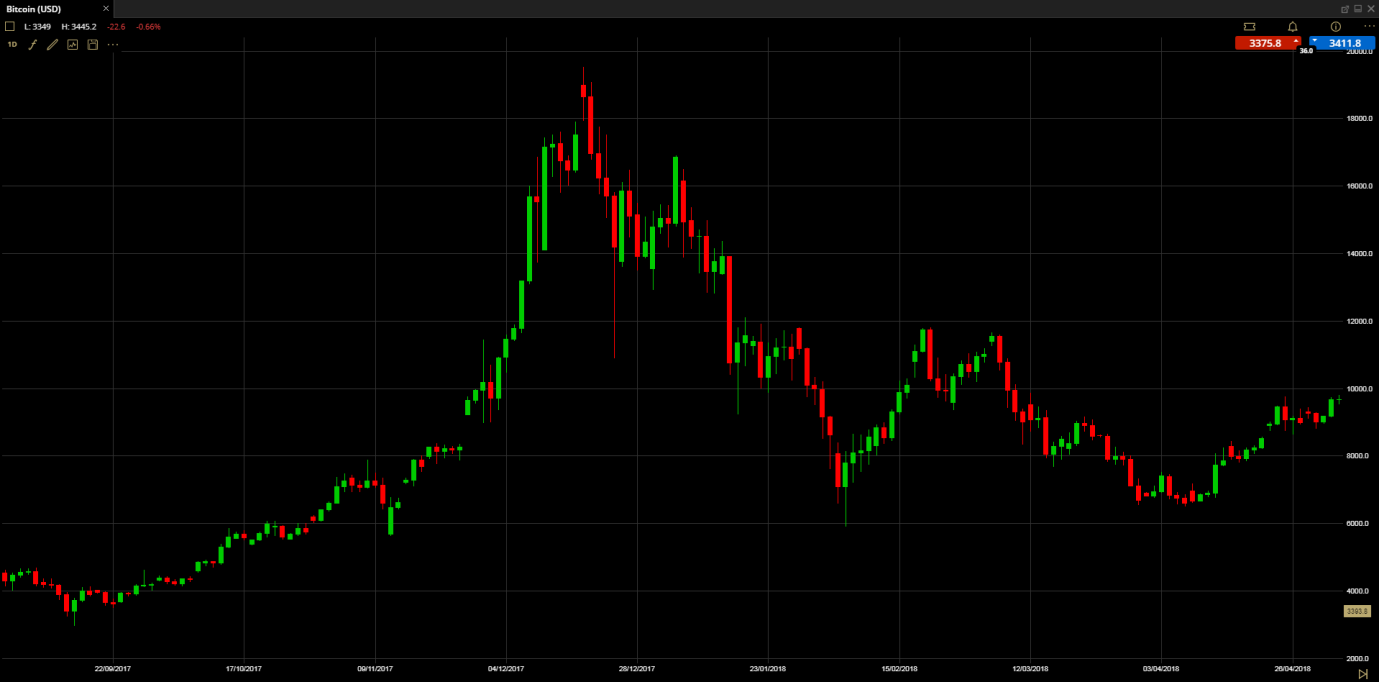Trader or not, the chances are you’ve heard of Bitcoin. It’s the ‘poster-crypto’ for the industry, and given that it has made a fair few investors insanely wealthy, there’s a plethora of information online about what it is and how you could capitalise on it.
Despite Bitcoin’s price being a fraction of what it was two years ago, its current value equates to 55% of the total market share of cryptos (worth a total of over $60 billion), so it’s still by far the strongest crypto out there. But there’s no getting away from the fact that its price is now less than a sixth of what it was at its peak, so is there actually a future for Bitcoin or has it had its day?
Firstly, the Bitcoin story so far…
Before getting into where it could go, let’s get a bit of context about where it all started. Bitcoin was created in 2009 by Satoshi Nakamoto (pseudonym) and was the first digital, decentralised currency. Since then, over 40,000 other cryptocurrencies have entered the market.
After a steady increase in the Bitcoin price (BTC/USD) in 2010, Bitcoin reached parity with the US dollar in February 2011 only a few days after 25% of the currency had been mined and entered circulation.
As of 1 April 2013, the exchange rate hit 100 USD to 1 Bitcoin. That was followed by a sharp rise towards the end of 2013 and subsequent smaller drop at the beginning of 2014. From then on, the price of Bitcoin steadily decreased for the next couple of years, reaching a low of around $200. A combination of factors may have been the cause, but many experts speculated false reports of a Bitcoin ban in China was a main reason.
It was 2017 where Bitcoin trading saw its price begin to really escalate. At the beginning of the year, it was at $1000. In September, it surpassed the $5000 level and just three months late (18 December), Bitcoin’s price peaked at just shy of $20,000 dollars. The incline was so rapid that markets opened at $11781 on 6 December, and closed the following day at $15676 – a rise of over 33% in the space of just two trading days.

Price of Bitcoin (against USD) at the time of the price escalation and subsequent crash in December 2017. Source: TraderPro.
The Bitcoin bubble bursting
Inevitably, such rapid inflation was not sustainable. What happened next was a devastating crash in late 2017; one that Bitcoin has still not recovered from. In mid-January, its price looked to potentially be stagnating at around the $15,000 mark, but then over just two weeks the price fell 50% – down to $7000. March saw it recover back up to over $11,000, but it has been in decline ever since and as of February 2019 resides around the $3500 mark.
Bitcoin’s competition
Many will be deterred by the $3500 price of Bitcoin, comparing it to its former highs of nearly six times that and declaring it too late to invest. However, when looking at other cryptos, Bitcoin is still performing exceptionally well.
That’s not to say Bitcoin is untouchable though. Altcoins (alternative cryptocurrencies to Bitcoin) do offer benefits, and were one of these crypto’s price to overtake Bitcoin’s, people may ‘jump ship’ to the better performing digital currency.
Ripple for example, offers quicker transaction times and cheaper transaction fees. Ethereum acts as a safe, digital exchange for contracts, agreements and other information. Litecoin, based on Bitcoin, was invented as a quicker, cheaper replica. With more and more cryptos being created each month, one of them is bound to eclipse Bitcoin in terms of functionality and usability, but it will just be a case of gaining enough traction and investor confidence in determining whether they will be able to compete.
Is there a future for Bitcoin or has it had its day?
One huge advantage that Bitcoin has over its competitors is its age. Being the first, and therefore the oldest, crypto means it’s already established an industry leader. At the same time, it can also be seen as a downside. Less than 20% of Bitcoin remain ‘unmined’ and as the last few are mined it will become increasingly more difficult to continue to do so. As a result, newer cryptos that aren’t as difficult to acquire and use newer technologies will be more appealing.
However, given Bitcoin’s stature, it’s hard to see its demand dropping completely unless an event causes the market to entirely crash.
One thing to note is that after the previous two times that Bitcoin’s mining reward has halved (50-25 in 2012 and 25-12.5 in 2016), an increase in the price has followed. This is assumingly based on the fact that Bitcoin becomes more difficult to acquire, as the same amount of mining will reap you half the reward, so one Bitcoin is considered more valuable. It may be something to look out for as Bitcoin continues to be mined and the next cut in reward comes in May 2020.
In society, Bitcoin is becoming more prominent by the day. Thousands of companies have accepted Bitcoin as a legitimate payment method. Microsoft has been a long-term advocate of Bitcoin, accepting it for its Xbox credits. Other major companies that accept Bitcoin are Expedia, airBaltic and Shopify.
As more global brands embrace and endorse cryptos and cash is being used less frequently, a digitalised currency could very well be the answer… And Bitcoin is poised and ready to capitalise.
Spread bets and CFDs are complex instruments and come with a high risk of losing money rapidly due to leverage. 81% of retail investor accounts lose money when spread betting or trading CFDs with ETX. You should consider whether you understand how spread bets orCFDs work and whether you can afford to take the high risk of losing your money.
Monecor (London) Ltd is a member firm of the London Stock Exchange. Authorised and regulated by the Financial Conduct Authority with Financial Services register number 124721.

Richard is the founder of the Good Money Guide (formerly Good Broker Guide), one of the original investment comparison sites established in 2015. With a career spanning two decades as a broker, he brings extensive expertise and knowledge to the financial landscape.
Having worked as a broker at Investors Intelligence and a multi-asset derivatives broker at MF Global (Man Financial), Richard has acquired substantial experience in the industry. His career began as a private client stockbroker at Walker Crips and Phillip Securities (now King and Shaxson), following internships on the NYMEX oil trading floor in New York and London IPE in 2001 and 2000.
Richard’s contributions and expertise have been recognized by respected publications such as BusinessInsider, Yahoo Finance, BusinessNews.org.uk, Master Investor, Wealth Briefing, iNews, and The FT, among many others.
Under Richard’s leadership, the Good Money Guide has evolved into a valuable destination for comprehensive information and expert guidance, specialising in trading, investment, and currency exchange. His commitment to delivering high-quality insights has solidified the Good Money Guide’s standing as a well-respected resource for both customers and industry colleagues.
